DJ controllers – Which type of jog wheel should you choose? Mechanical vs. capacitive platters? When choosing a DJ controller or a player, it’s important to have at least the basic knowledge of the types of jog wheels you can find on these types of devices. Whether you are (or you plan to become) a scratch DJ, a club DJ, or a bit of both, you need to know which type of jog wheels to choose and which kind will be the best for you.
- Old type mechanical jog wheels
- Capacitive jog wheels
- Mechanical jog wheels
- Motorized jog wheels
- Capacitive vs. mechanical jog wheels
- DJ controller jog wheel types – summary
This web portal is reader-supported, and is a part of the Amazon Services LLC Associates Program and the eBay Partner Network. When you buy using links on our site, we may earn an affiliate commission!
Old type mechanical jog wheels
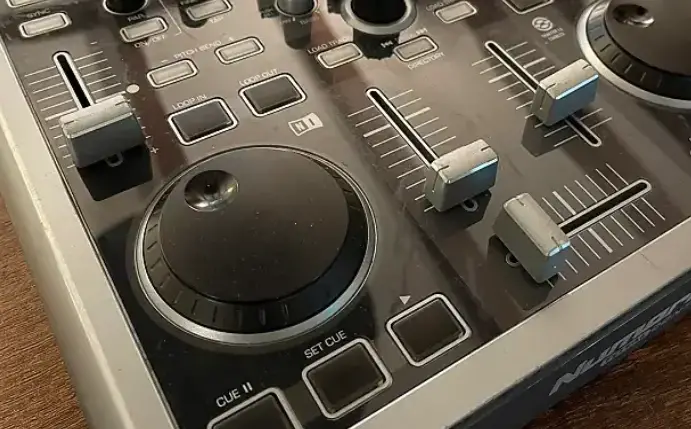
Old type mechanical jog wheels are a very simple and bare bones type of mechanism – they are essentially jog wheels based on a simple bearing, without any kind of touch recognition capabilities, with slow response, small in size and unfit for scratching.
These type of jog wheels can be typically found in older DJ gear (more than a decade old), video editing equipment (!) and some cheap entry-level DJ controllers.
In essence they can only be used for searching throughout your tracks and track synchronization time corrections (pitch bending).
Important: Don’t mistake the old type mechanical jog wheels for contemporary mechanical jog wheels present in modern DJ players (which we’ll cover in a short while).
In the photo example, we can see the old type mechanical jog wheels on a Numark Total Control DJ controller (long discontinued). These jog wheels are a really simple mechanism based on a bearing that ensures their smooth movement and long spin.
It’s important to note that these types of jog wheels are highly unreliable in any modern DJ equipment – they have a slow reaction time, can’t register whether or not you are actually touching their surface and don’t let you easily scratch or hold your track “in place” using your hand. They also are not able to “release” the track immediately after you take your hand off them – there is always a noticeable delay after letting go of the wheel.
If you want to know more about issues connected with the very first generations of simple mechanical jog wheels, you can take a look at the first part of this article here: Sound Delay After Letting Go Of The Jog Wheel – How To Fix
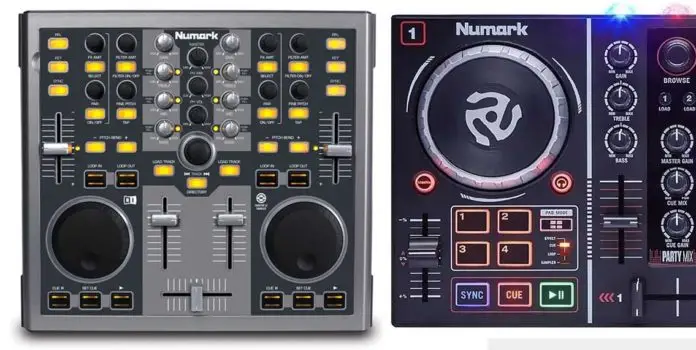
Today, you can still find some entry-level DJ controllers on the market that feature these older types of jog wheels. To name a few, Numark Party Mix 1 and the first version of the Numark DJ2GO2 still make use of this technology (although they both already have updated versions with capacitive jog wheels on board – Numark Party Mix 2 (Amazon | Ebay), and the DJ2GO2 Touch (Amazon | Ebay).
Modern mechanical jog wheels on the other hand, (like the ones found on the Pioneer CDJ or Denon PRIME players for example), are a totally different thing. These are not only suitable for scratching, but are also more reliable and often preferred to their popular capacitive counterparts. More on these later.
Capacitive jog wheels
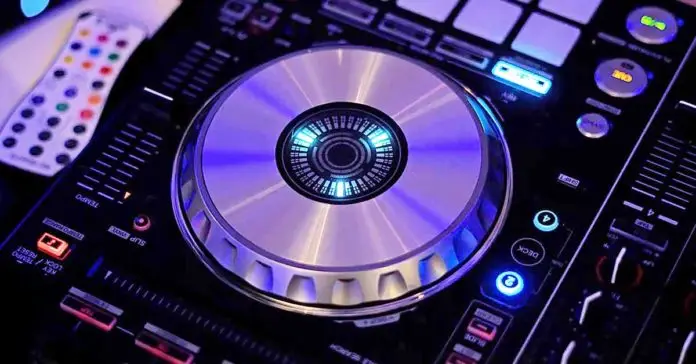
Capacitive jog wheels are the most common and widespread ones when it comes to DJ controllers (both “entry-level” and “professional” ones).
Capacitive platters use their touch sensitive top surface to detect when your hand is touching them. You don’t have to apply any pressure to them for the touch to register, and while that’s great, this also makes it so that they can be easily activated by accident.
These types of jog wheels are a cost efficient and versatile solution and it’s one of the reasons of their popularity among DJ gear manufacturers.
Did you know? DJ controllers featuring capacitive jog wheels almost always also feature a button that enables you to turn the “vinyl” mode of the jog wheel platter on and off. If you press the button, the whole jog wheel surface will act as the edge of the platter (so as a pitch-bend control) and so, you won’t risk disrupting your track playback with accidental jog wheel touches.
Mechanical jog wheels

Modern mechanical jog wheels are found mostly in standalone Pioneer CDJ players (for instance Pioneer CDJ-2000NXS (Amazon | Ebay) or the Pioneer CDJ-3000 (Amazon | Ebay).
These types of jog wheels are based on a bearing that detects the directional movement of the platter. Mechanical jog wheels need to be pressed down just a little bit for them to recognize that you’re touching their surface. Simply putting your finger lightly on their top part won’t make them register your touch.
CDJ vs. DDJ – Differences & Comparison (DJ Gear)
Mechanical jog wheels are almost always bigger than capacitive ones and they make a little bit more noise when being turned because of the bearings used.
They are often preferred by club DJs, as they’ve been featured in almost all “club-standard” Pioneer CDJ player models since the beginning of the series.
Another thing is that mechanical jog wheels often tend to be more accurate than capacitive ones. There are some issues connected with capacitive jog wheels (such as hardware touch detection related latency problems), that are really rare when it comes to mechanical ones.
Sound Delay After Letting Go Of The Jog Wheel – How To Fix
Note: not all DJ players feature mechanical jog wheels – the Denon DJ PRIME player series for instance come in two variants: one with capacitive jog wheel and one with a motorized platter.

Did you know? The Pioneer DDJ-1000 (Amazon | Ebay) and the Pioneer DDJ-1000SRT (Amazon | Ebay) are one of the few DJ controllers that actually feature full size mechanical jog wheels. These are almost the same ones present on the Pioneer CDJ player series – except the built-in displays which are a nice bonus!
Motorized jog wheels

Motorized jog wheel platters recently became a very popular solution on the DJ equipment market. We already have quite a few DJ controllers making use of these (like the Pioneer DDJ-Rev7 (Amazon | Ebay), and even players featuring them (such as the Denon SC6000M (Amazon | Ebay).
Jog wheels with built in motors are a real treat for DJs who want to emulate the traditional vinyl mixing experience on a DJ controller. Although they certainly don’t feel the same as spinning a real vinyl record, depending on the controller they may come really close.
5 Best DJ Controllers With Motorized Platters (Top List)
Did you know? On some DJ controllers with motorized platters you are able to control the speed and torque of the motor and turn the motor on and off depending on your preference.
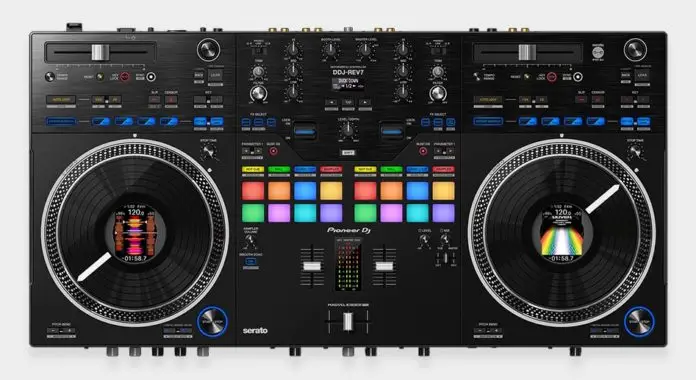
If you’re looking for a professional high-end DJ controller featuring motorized jog wheel platters, you should really take a look at the Pioneer DDJ-Rev7 (Amazon | Ebay). The second worthwhile option here would be the main rival of the Rev7 – the Rane ONE (Amazon | Ebay).
More DJ controllers with motorized platters here: Best DJ Controllers With Motorized Platters (Full List)
Capacitive vs. mechanical jog wheels
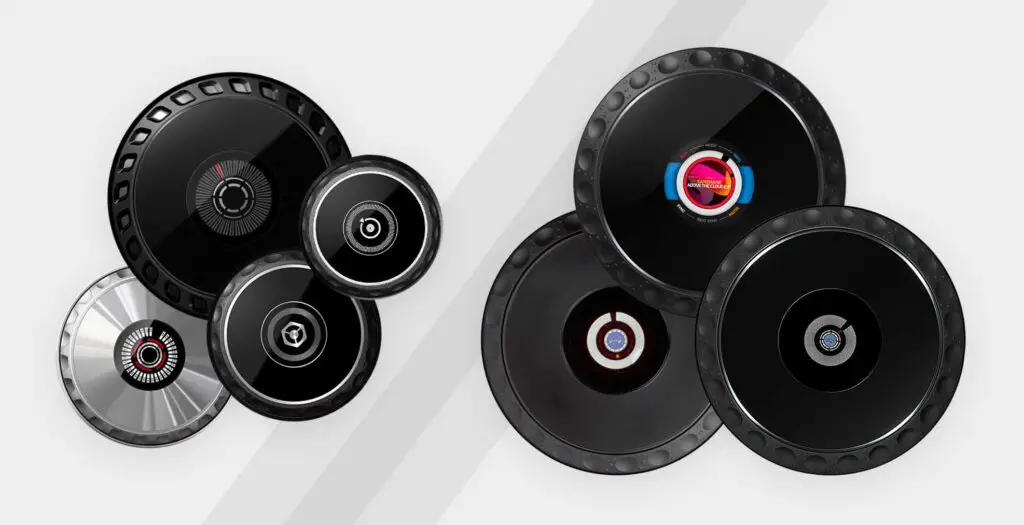
Jog wheels – capacitive or mechanical? These two main types of jog wheels are often juxtaposed and compared, especially by more experienced DJs.
Capacitive jog wheels can be found on most modern DJ controllers. They are reliable and versatile and nowadays its hard to find a DJ controller that doesn’t make use of them.
Mechanical jog wheels on the other hand are more commonly found on the higher-end Pioneer CDJ players, and they are typically larger in size in comparison to capacitive jog wheels on most DJ controllers. If you tried these before and enjoy how they feel, they might be a better choice for you.
When it comes to comparing mechanical jog wheels to capacitive ones, it’s almost always more about comparing the DJ gear featuring either of these. In terms of the jog wheels themselves you really have to try both of them to assess which type is better for you.
- Did you know? Pioneer DDJ-1000 (Amazon | Ebay) and Pioneer DDJ-1000SRT (Amazon | Ebay) are the only Pioneer DJ controllers featuring the exact same mechanical jog wheels you can find on Pioneer CDJ-2000NXS players!
- Pioneer DDJ-FLX6 (Amazon | Ebay) is an entry-level DJ controller with capacitive jog wheels which are close to the Pioneer CDJ jog wheel size.
DJ controller jog wheel types – summary
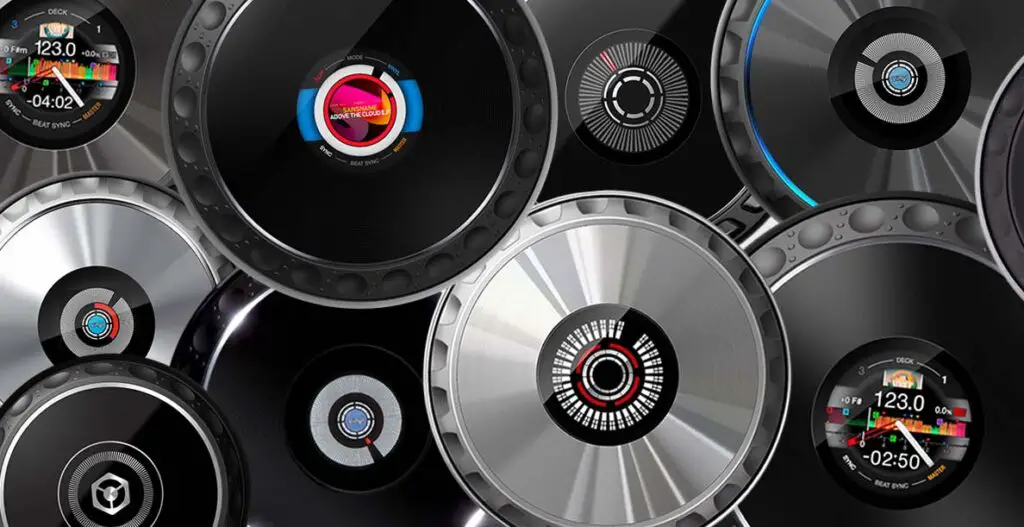
To sum it all up, there are 4 main types of jog wheels present on modern DJ equipment:
- Old type mechanical jog wheels – legacy technology, mostly deprecated.
- Capacitive jog wheels – with touch sensitive surface, present on most DJ controllers.
- Mechanical jog wheels – most often seen on standalone DJ players.
- Motorized jog wheels – jog wheels with motors built in, meant to emulate classic vinyl mixing experience.
In general, while the old-fashioned mechanical jog wheels as mentioned in the first part of this article should be avoided, the choice between capacitive, mechanical and motorized jog wheels is all about your personal preferences.
Scratch DJs will most probably prefer motorized platters, while club DJs are often more likely to go for mechanical jog wheels on their players. In most cases, beginner DJs will first have contact with capacitive platters that are currently the most popular solution on the market.
Whatever type of jog wheel you’ll choose in the beginning you won’t be disappointed. Best thing to do, if you have the possibility to do that, is to try each type in your local music store (if only they have DJ gear on display). If you have any more questions, please ask in the comments below. Rock on!

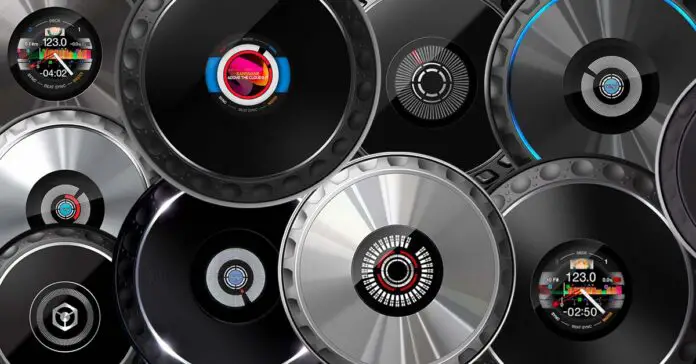
[…] Jog Wheel Types Explained – DJ Equipment Guide […]